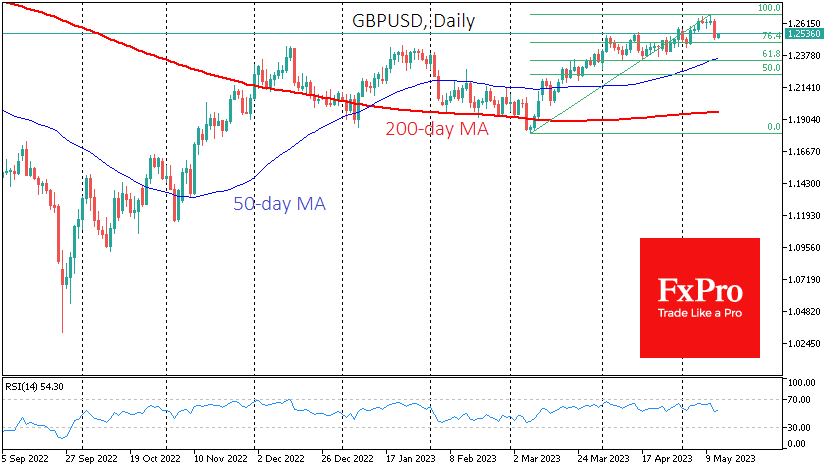The Bank of England raised its key interest rate by 25 points to 4.5% on Thursday, marking the twelfth consecutive policy tightening. Two of the nine members have voted to keep rates on hold in the last four meetings.
The accompanying commentary left the door open for a further hike and a pause. Arguing in favour of further tightening is the more resilient inflation in the UK, forcing the central bank to raise its rate forecasts regularly. On the other hand, the central bank has done a considerable amount of work so far, and it will take some time for the hikes already made to have their full effect on the economy.
You could say that the Bank of England is trying to go in the same direction as the Fed by stopping rate hikes. A similar signal from the Bank of England could be stronger than the Fed. But the nominal interest rate level in the UK is now lower than in the US when historically the opposite is true.
The reaction of sterling has been interesting. The initial rise of a third of a per cent was wiped out by a triple-digit fall before the end of the day, taking GBPUSD back to 1.25. The market players continued to pocket profits after the Pound's rally since early March, recalling the adage 'sell in May and go away'. A retracement of the GBPUSD could occur around 1.2350, a 61.8% retracement of the March-May rally, local support from April and the 50-day moving average.
It is also worth noting that the Bank of England is now benefiting from the appreciation of its currency against its main rivals, as rising import prices significantly contribute to inflationary pressures. As such, we expect the Bank of England to adopt more hawkish rhetoric than the Fed in the coming months, which will support the GBPUSD to rise to the 1.30 area after the correction of the recent rally with a pullback to 1.2350.
The FxPro Analyst Team
- English (UK)
- English (India)
- English (Canada)
- English (Australia)
- English (South Africa)
- English (Philippines)
- English (Nigeria)
- Deutsch
- Español (España)
- Español (México)
- Français
- Italiano
- Nederlands
- Português (Portugal)
- Polski
- Português (Brasil)
- Русский
- Türkçe
- العربية
- Ελληνικά
- Svenska
- Suomi
- עברית
- 日本語
- 한국어
- 简体中文
- 繁體中文
- Bahasa Indonesia
- Bahasa Melayu
- ไทย
- Tiếng Việt
- हिंदी
Pound Corrects March-May Rally But Has Not Completed It
Published 05/12/2023, 08:42 AM
Updated 03/21/2024, 07:45 AM
Pound Corrects March-May Rally But Has Not Completed It
Latest comments
Loading next article…
Install Our App
Risk Disclosure: Trading in financial instruments and/or cryptocurrencies involves high risks including the risk of losing some, or all, of your investment amount, and may not be suitable for all investors. Prices of cryptocurrencies are extremely volatile and may be affected by external factors such as financial, regulatory or political events. Trading on margin increases the financial risks.
Before deciding to trade in financial instrument or cryptocurrencies you should be fully informed of the risks and costs associated with trading the financial markets, carefully consider your investment objectives, level of experience, and risk appetite, and seek professional advice where needed.
Fusion Media would like to remind you that the data contained in this website is not necessarily real-time nor accurate. The data and prices on the website are not necessarily provided by any market or exchange, but may be provided by market makers, and so prices may not be accurate and may differ from the actual price at any given market, meaning prices are indicative and not appropriate for trading purposes. Fusion Media and any provider of the data contained in this website will not accept liability for any loss or damage as a result of your trading, or your reliance on the information contained within this website.
It is prohibited to use, store, reproduce, display, modify, transmit or distribute the data contained in this website without the explicit prior written permission of Fusion Media and/or the data provider. All intellectual property rights are reserved by the providers and/or the exchange providing the data contained in this website.
Fusion Media may be compensated by the advertisers that appear on the website, based on your interaction with the advertisements or advertisers.
Before deciding to trade in financial instrument or cryptocurrencies you should be fully informed of the risks and costs associated with trading the financial markets, carefully consider your investment objectives, level of experience, and risk appetite, and seek professional advice where needed.
Fusion Media would like to remind you that the data contained in this website is not necessarily real-time nor accurate. The data and prices on the website are not necessarily provided by any market or exchange, but may be provided by market makers, and so prices may not be accurate and may differ from the actual price at any given market, meaning prices are indicative and not appropriate for trading purposes. Fusion Media and any provider of the data contained in this website will not accept liability for any loss or damage as a result of your trading, or your reliance on the information contained within this website.
It is prohibited to use, store, reproduce, display, modify, transmit or distribute the data contained in this website without the explicit prior written permission of Fusion Media and/or the data provider. All intellectual property rights are reserved by the providers and/or the exchange providing the data contained in this website.
Fusion Media may be compensated by the advertisers that appear on the website, based on your interaction with the advertisements or advertisers.
© 2007-2025 - Fusion Media Limited. All Rights Reserved.
